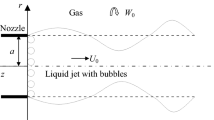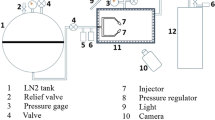Abstract
Effervescent jet breakup-based gas expansion disturbance was studied by the combination of experiment and numerical methods. A transparent outside-in-type atomizer was used to observe both internal and external gas–liquid flow behavior. Effects of internal flow patterns and flow rates on gas expansion bulge were experimentally studied. Further analysis on the disturbance of gas expansion on jet breakup was conducted through the numerical method. The present work showed the results of gas expansion disturbance exiting under various internal flow regimes. Increasing gas–liquid flow rates enlarges spray angle and gas expansion bulge, decreases adjacent gas bulges’ distance, and leads to a more stable spray. Detailed numerical results demonstrated that the gas expansion advancing jet breakup was enhanced by enlarging instantaneous gas volume and internal pressure. For efficient utilization of gas expansion potential energy, small bubble formation is suggested.
Graphical Abstract

















Similar content being viewed by others
References
Bleau A, Leon LJ (2000) Watershed-based segmentation and region merging. Comput Vis Image Underst 77:317–370
Buckner HN, Sojka PE (1991) Effervescent atomization of high-viscosity fluids: Part I. Newtonian liquids. Atomization Sprays 1(3):239–252
Canny J (1986) A computational approach to edge detection. IEEE Trans Pattern Anal Mach Intell PAMI 8(6):679–698
Catlin CA, Swithenbank J (2001) Physical processes influencing effervescent atomizer performance in the slug and annular flow regimes. Atomization Sprays 11(5):575–595
Gadgil HP, Raghunandan BN (2011) Some features of spray breakup in effervescent atomizers. Exp Fluids 50(2):329–338
Hirt CW, Nichols BD (1981) Volume of fluid (VOF) method for the dynamics of free boundaries. J Comput Phys 39(1):201–225
Jedelsky J, Jicha M (2013) Energy conversion during effervescent atomization. Fuel 111(9):836–844
Kim JY, Lee SY (2001) Dependence of spraying performance on the internal flow pattern in effervescent atomizers. Atomization Sprays 11(6):735–756
Konstantinov D, Marsh R, Bowen PJ, Crayford A (2010) Effervescent atomization for industrial energy-technology review. Atomization Sprays 10(6):525–552
Kothe DB, Rider WJ (1998) Reconstructing volume tracking. J Comput Phys 141(2):112–152
Launder BE, Spalding DB (1972) Mathematical models of turbulence. Von Karman Institute for Fluid Dynamics
Lefebvre AH (1988) Atomization and sprays. Hemisphere Pub Corp
Lin JZ, Qian LJ, Xiong HB (2009a) Effects of operating conditions on droplet deposition onto surface of atomization impinging spray. Surf Coatings Technol 203(12):1733–1740
Lin KC, Carter C, Fezzaa K, Wang J, Liu Z (2009b) X-ray study of pure- and aerated-liquid jets in a quiescent environment. American Institute of Aeronautics and Astronautics, Paper 2009–0994
Lü M, Ning Z, Yan K, Fu J, Sun CH (2016) Numerical simulation of cavitation bubble growth within a droplet. J Mech 32(2):211–217
Shepard TG (2011) Bubble size effect on effervescent atomization. Ph.D. dissertation, University of Minnesota, Twin Cities
Sovani SD, Sojka PE, Lefebvre AH (2001) Effervescent atomization. Prog Energy Combust Sci 27(4):483–521
Sun CH, Ning Z, Lü M, Yan K, Fu J (2016) Acoustic performance of effervescent sprays by time-frequency method with different atomizer structures under different operating conditions. Int J Multiph Flow 82:35–48
Wang X, Chin JS, Lefebvre AH (1989) Influence of gas injector geometry on atomization performance of aerated liquid nozzles. Int J Turbo Jet Eng 6(3–4):271–279
Yu G, Li JG, Zhao JR, Yue LJ, Chang XY, Sung CJ (2005) An experimental study of kerosene combustion in a supersonic model combustor using effervescent atomization. Symp Combust 30(2):2859–2866
Funding
Project supported by the National Natural Science Foundation of China (Grant Nos. 51776016, 51606006,91741122), Beijing Natural Science Foundation (Grant Nos. 3172025, 3182030), and the National Engineering Laboratory for Mobile Source Emission Control Technology (Grant No. NELMS2017A10).
Author information
Authors and Affiliations
Corresponding authors
Ethics declarations
Conflict of interest
The authors report no conflicts of interest in this work.
Rights and permissions
About this article
Cite this article
Sun, C., Ning, Z., Qiao, X. et al. Study of effervescent jet breakup under gas expansion disturbance. J Vis 21, 935–948 (2018). https://doi.org/10.1007/s12650-018-0502-6
Received:
Revised:
Accepted:
Published:
Issue Date:
DOI: https://doi.org/10.1007/s12650-018-0502-6




